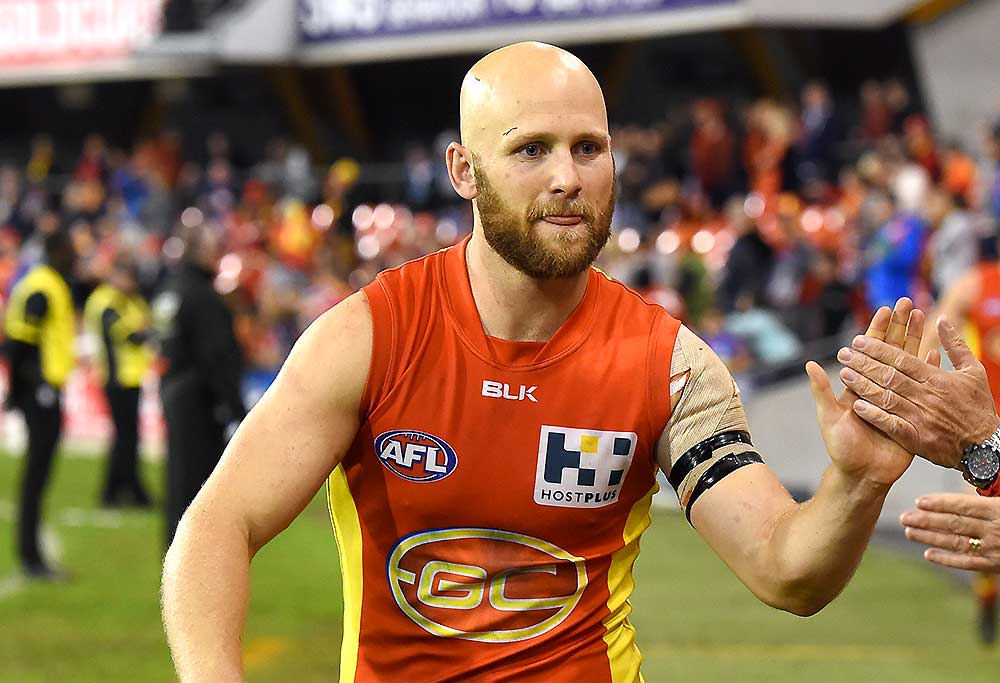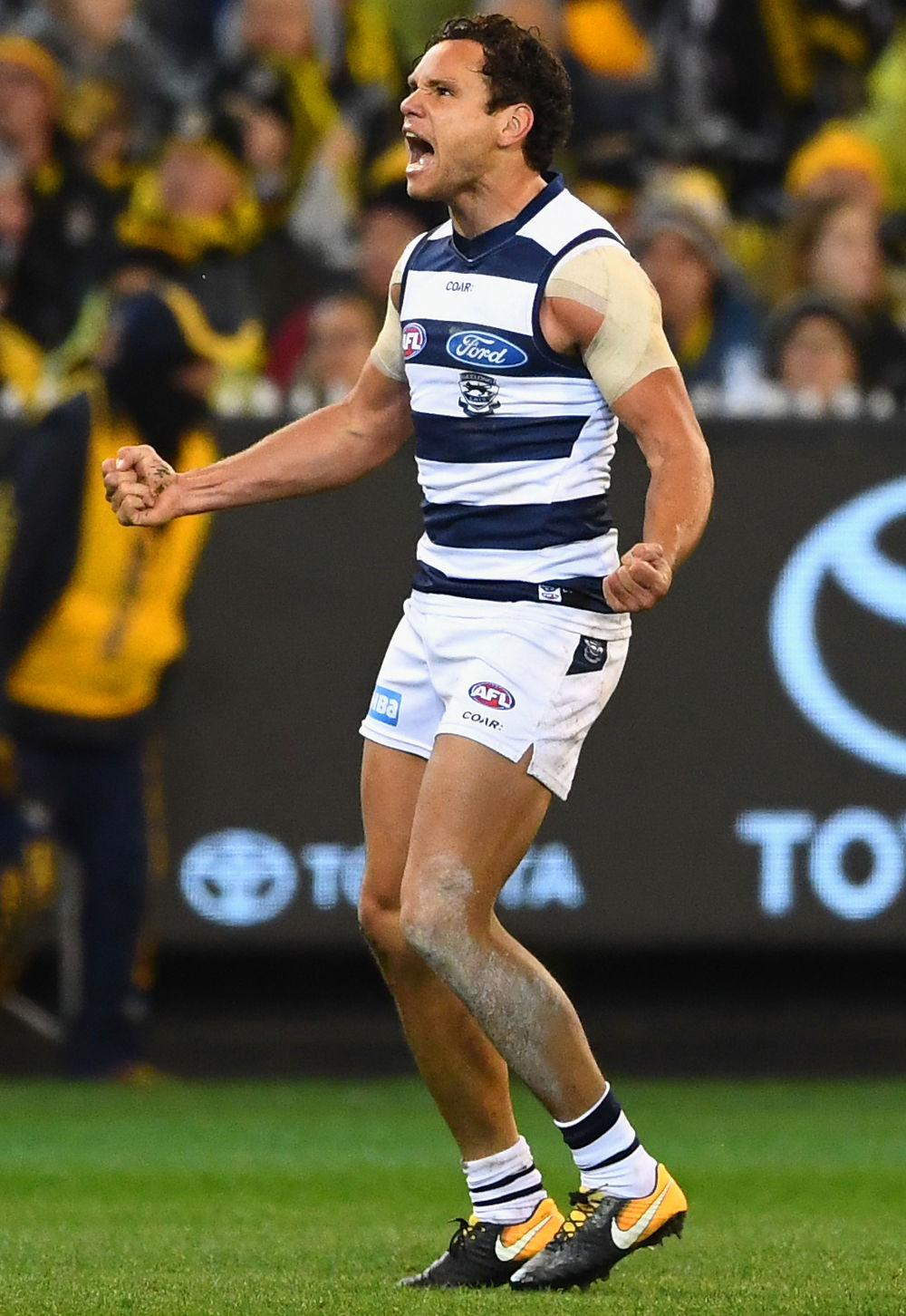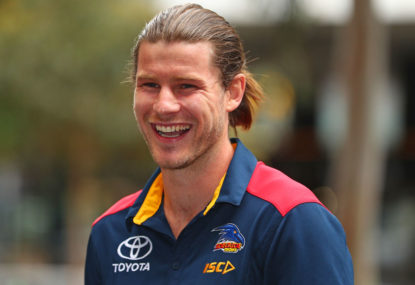The instant-reaction sound bites of last Friday are a distant memory. Now we have had some time to let the 34 deals percolate in our brains, who really won the AFL trade period?
Collingwood, Sydney, North Melbourne and Richmond had quiet fortnights, making few moves and seemingly content with where things sit. Either that or there was nothing on the board that tickled their fancy.
According to some elements, that makes them losers in and of itself; “why didn’t you make a trade!” the dozens of media cry on the carpet of Etihad Stadium as the final hour frenzy reached its conclusion.
It’s the sort of fingernail-deep analysis – as Ross Lyon calls it – that leads to statements like “North Melbourne is ten years away from competing for a premiership.”
Instead, let’s deal with a few matters in a little more depth than they’ve been covered elsewhere.
We might as well start with the biggest – and best, for both sides – deal of the fortnight, and one which reportedly wasn’t considered until the final couple of days of trade period.
Carlton and Adelaide are both winners from the Bryce Gibbs deal
The instant take – I was guilty of this – was to rate this as a swindle of the highest order by Stephen Silvagni and the Carlton Blues football department. Two first round picks for a guy about to enter his 29-year-old season? Yikes, not good.
But then the details filtered through, and the grey matter got to work, and all of a sudden the nuance of the deal burst through.
The critical piece is Carlton’s 2018 second and third round picks, conveying to the Adelaide Crows along with Gibbs for Pick 10 and Pick 16 (some more minor swaps also took place). This differs significantly from last year’s ‘two first round picks for Gibbs’ deal, which was literally two first round picks for Gibbs’ signature. Those future picks help make this a clear win-win for both parties.
Adelaide get a flexible and durable midfield piece, who can and will rotate from the inside to the outside as other personnel moves dictate. Gibbs with Rory Sloane, Matt Crouch and Brad Crouch form a ‘Big Four’ that might not have the name recognition of Geelong’s quarter, but which affords just as much midfield punch. Add more Rory Laird midfield time to the mix and suddenly the Crows find themselves with a stacked core midfield group that’ll steamroll most – if not all – of the league.
With Gibbs, the Crows aren’t just getting a couple of years of prime-age production, they’re getting a player who has missed just over a dozen games in an 11-year career, and whose game is primed for an old folks home transition to the half back line.
Adelaide might have sold themselves out of two 200 game players from this draft, but equally they might have avoided selecting two 10 game busts. There is nothing to suggest Gibbs will play less than five seasons for the Crows, which would be more than 100 games.
Carlton gets to take three picks inside the top 20 for the second time in three years, helping their rebuilding cause even if this year’s draft is ‘thin’ and ‘not as good as next year’ (aren’t they all?). They held out on Gibbs for two years longer than they perhaps should have, although given they were still able to net two first round picks suggests it might have been less of a gambit than predicted.
But here’s the kicker. The Blues received Picks 10 and 16 for Gibbs, but to get the deal over the line Carlton also gave up their 2018 second round pick. That pick could land anywhere from 20 through 40 (depending on free agency and player bidding). The risk for the Blues is they end up slipping a little further down the ladder as a result of swapping Gibbs for a young player, and ultimately conveying that pick over to the Crows with a relatively small number attached.
Will it matter? It’s hard to say now with all the balls still floating in the air. The Blues have next year to think about its draft and trade strategy for next year’s draft, so to flip that pick and Gibbs for two additional shots in this year’s draft is a smart play. There’s no clock on Carlton’s rebuild.
For Adelaide, it arguably still looks like an overpay. But when you consider the broader context of the Crows and their off season, it falls into place.

AAP Image/Joe Castro
Adelaide has its cake and eats it too
Both sides, and the player himself, denied a move was on all through the first week, and it wasn’t until the final day that a Gibbs transaction looked possible.
What changed? My theory is the Crows were happy to meet Carlton in the middle – or slightly on the Blues side of the spectrum – because of the assets received from Melbourne for Lever. It meant that through the Gibbs deal, Adelaide had gained Gibbs and a bevvy of 2018 picks: 10, 18, 22, 36 and 40 if you add Adelaide’s own picks following next season.
In net terms, it meant the loss of Lever and two 2017 first round picks, but if it is a smart strategy for the Blues to cluster high picks in one year then it’s also smart for Adelaide to do so. Lever was on his way out anyway, and the Crows have plenty of tall fellows to pick up the slack – particularly given Lever mostly played a spare man role.
Comfortable with the knowledge its 2018 was secure, the Crows were also able to hold firm their demand for a current year pick of 20 or better for Charlie Cameron from the Brisbane Lions; they ended up with Pick 12. Adelaide also added the reliable Sam Gibson to their list for nothing, presumably picking him up for a pick in the 90s instead of waiting until delisted free agency as a goodwill gesture to North Melbourne.
The Crows had their cake and ate it too. Given the two best 22 players lost wanted to leave, the haul Adelaide landed was immense. Their present has been fortified, and their future secured.
Essendon’s hidden Tiger streak
Speaking of future, the Bombers contributed meaningfully to theirs in a daring raid on established talent.
Adam Saad, Devon Smith and Jake Stringer are all power players, doing their best work creating space with their attack on the ball. Critically though, Saad, Smith and Stringer are in the final years of their pre-prime, being 23, 24 and 24 (just) respectively at the start of next season.
Saad goes to the half back line, likely taking Rising Star winner Andrew McGrath’s place as he begins to work his way into midfield. With the rangey Connor McKenna on the other flank, the pair might be known as the Dash Brothers before too long.
Smith and Stringer have played predominately in the forward line for their previous teams, but more midfield time will be coming both of their ways as the Bombers lose Jobe Watson and James Kelly, and Brendon Goddard moves permanently to half back. The perfectly adequate Ben Howlett was also delisted earlier this week, signalling Essendon’s intentions.
It will give the Bombers some deep flexibility in the forward half of the ground, allowing them (for example) to go small around Joe Daniher or to play a more traditional set up with Jake Stringer at centre half forward, Daniher in the goal square and Cale Hooker to play as the tall flanker.
The Dons punted this year’s draft to make these moves happen, but do they really need another group of teenagers at this point in their list development?
Their off season moves hark back to this time last year, when Richmond patched up a few cracks in their list with some near-prime talent. No one thought the Tigers were going to go on to win a flag, but Dion Prestia, Josh Caddy and Toby Nankervis all played important roles.
It extends beyond ‘adding three players from other clubs’ though; there’s an element of happenstance in both off seasons. Richmond had been circling Prestia for some time, but Nankervis and Caddy came out of the clouds in many ways. Ditto the Essendon trio; coming into the trade period Smith was a certainty to head to Geelong, while the Saad and Stringer transactions weren’t even contemplated. For a while it looked like Stringer was on his way to Geelong along with Smith – I even wrote about it.
As it came to be, Essendon scooped the pool, and loom once more as a fascination heading into the preseason.

Photo by Jason O’Brien/AFL Media/Getty Images
Gary Ablett is home, and Geelong is scary once again
“It was good Gary ended up at Geelong. We’ve given up a bit to do that in next year’s draft and also this year’s draft, but it’s a great story.”
In an industry growing ever-more famous for its spin, this is a factually correct statement from Cats list manager Steven Wells.
Wells also went on to reference Ablett winning Gold Coast’s best and fairest – resisting the temptation to say he did it playing 14 games – which is also relevant to this discussion.
After protracted negotiations, as the Suns tried to prise out a Geelong player for Ablett, Gold Coast received Pick 19 and Geelong’s 2018 second round pick (in the late 30s one would assume) for Ablett, Pick 24 and next year’s fourth round pick (in the 70s). That the Suns received a sizeable bump in the draft for Ablett suggests their opening gambit of requesting a player could have helped set a high peg for the negotiations.
There is reportedly some salary cap shifting going on in the background, but given this is all opaque it’s difficult to countenance its contribution to the exchange.
While ‘trading for two-time Brownlow medallist, two-time premiership player, multiple best and fairest winner, perennial All Australian, career 25 disposals, 1.3 goals per game player Gary Ablett’ has a certain connotation, Ablett has played 15, six, 14 and 14 games over the past four seasons – the first year ending early by a serious shoulder injury and the remainder impacted by this and other niggles.
His odometer ticked over the 300-game mark this season, clearly his last major-games-played milestone.
He could have 30 games left in him over two seasons, based on recent history. Given that, the value Geelong gave up looks on the high side. But what are the 30 games worth to the Cats at this point of its development? Suddenly merely downgrading draft positions looks a more reasoned bet on the strength of their existing playing list.
Geelong end the year as a known quantity, bar the role the returning Ablett will play. He and Dangerfield as an attacking midfield duo will be appointment viewing so long as the master is on the park.

AAP Image/Dave Hunt
No conspiracy
After two frantic years of list construction around the primes of Patrick Dangerfield, Joel Selwood and Tom Hawkins, this was the only material move of Geelong’s off season. They lost Darcy Lang to the Blues, but he looked just as likely to be delisted as find a home outside of Kardinia Park.
The other change was the departure of Steven Motlop, which given the byzantine nature of free agency compensation, net the Cats an end of first round pick.
The cries of conspiracy followed as quick as ever, and it wasn’t helped by the eventual use of the pick (Pick 19) in the deal which bought Ablett home. This is in the second band of compensation, only behind a first round pick immediately after a team’s actual first round pick.
This was also the compensation Brisbane received for its loss of Tom Rockliff, albeit the pick conveyed above Geelong’s on account of the finishing position. Both Rockliff and Motlop signed on for four years; Rockliff for a reported $650,000 per annum versus Motlop at ‘over’ $500,000 a season. Rockliff will be 28 when the season rolls around, and Motlop 27.
These are important details: the details that the AFL supposedly uses to calculate compensation picks. I say supposedly because it appears to change every year. In 2015, for example, a player had to be in the top 15 per cent of wage earners aged 25 or older to earn a top band compensation pick.
We don’t know what the salary band that would qualify for top 15 per cent of players aged 25 or older, but we do know for all players that played a game in 2016 the magic line fell somewhere between the $400,000 and $500,000 threshold reported by the AFL in its annual TPP summary.
The difference between Rockliff and Motlop is their age and reported salary. Ergo, subjectively, Motlop can’t be worth the same band of compensation pick as Rockliff – mostly on account of the salary. Ergo, the AFL rigged the system to give Geelong a higher pick than they should have been given to assist in the quest for Ablett. Ergo, conspiracy.
Not so fast.
First, we have no way of knowing whether Motlop’s reported salary is correct. It is worth noting the only source of Motlop’s salary is Fox Sports’ digital pages, which are not exactly the New York Times. Second, we don’t know what the salary band for top second tier compensation looks like. For instance, Rockliff could be at the top and Motlop at the bottom of the range. Third, it’s too damn obvious for the league to have fiddled.
I can’t say categorically either way, but I would defer to a logical explanation before moving to the hysterical.
That’s not to say the AFL should get off scot-free. There is no excuse for the league to keep its compensation formula secret. There are increasingly tenuous reasons for the league to keep player salaries secret, at least by way of established players earning above a certain threshold. Transparency kills conspiracy.

Photo by Quinn Rooney/Getty Images
The Lachie Weller overpay
Finally, a word on the Lachie Weller overpay. This is what we will come to call this trade the next time a club makes a time-pressured decision to hand over a prized asset for a middle-of-the-range player.
It scrambles my brain to live in a reality where Fremantle swindled a high pick from an opposition club.
Weller didn’t finish inside the top ten of Fremantle’s 2017 best and fairest. His trade request came completely out of left field. Fremantle’s moonshot request for Pick 2 looked like a joke. Then, at two minutes to midnight – literally – Gold Coast wilted.
The Suns will argue a homesick Gold Coast ex-pat in the hand is worth a homesick Victorian in the bush, no matter the price. That may be true, but anyway you cut it this is one of the more staggering trades in recent history.
It is almost enough to crown the Dockers winners of this trade period. They lost Weller, Harley Balic and Hayden Crozier, plus almost all of their draft hand for next year. They gained Nathan Wilson, Brandon Matera, Pick 2, and a bunch of lint from the pockets of a few other clubs.
But we don’t crown winners and losers, because it is too early, and it’s facile to crown winners and losers anyway.
Besides, we don’t know one of the most important pieces of information regarding the 2018 season yet: the fixture. That comes next week, when we tie a bow on the 2017 season.

































































































